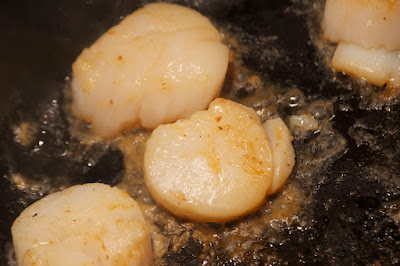Today, I'd like to branch out a bit from recipes, and talk a bit about sodium. And time. And the beautiful things that sodium can do for you.
 |
Sodium gets a bad rap for a variety of reasons. It's often used in lieu of other, more flavorful, ingredients, in order to make cheap things tasty (both as salt, and in conjunction with glutamates, as MSG). It has a reputation for causing high blood pressure and heart disease. (An undeserved one, by the way. Check out the Cochrane Report on salt and hypertension for the current state of medical science. In summary, it does have minor effects on blood pressure, but only on the order of a point. And a reduced sodium diet can lead to increases in cholesterol and triglyceride levels, which are rather more strongly correlated with heart disease than blood pressure.) However, it can still have bad effects on the kidneys in large amounts. Given all that, a lot of people over-react, and try to avoid salt entirely.
I don't advocate going off and eating salt by the tablespoon, and most pre-prepared foods have far more salt than they need. However, when you're scratch cooking, a little salt at the right time can do wonders for your cooking.
- Salt is tasty
- Salt is a natural preservative
- Salt is a meat and vegetable tenderizer
- Salt softens beans and helps them cook faster
- Salt makes bread dough more elastic
- Salt makes eggs more tender
Let's wander down the garden path of chemistry for a bit, and talk about why some of these things are all true. Salt is composed of sodium and chlorine, in an ionic bond. However, like some couples we all know, all it takes is a little liquid, and the bond becomes very weak, breaking the salt into a sodium and a chlorine ion (charged particle). Now, sodium and chlorine are both notoriously promiscuous and will cheerfully glom on to anything that will have them. (I'm going to run this metaphor for all it's worth!) When you put salt in bread, the sodium will happily hook up with the gluten, and cross link it, so that many long chains of gluten are stuck together in a matrix (kind of like a snarl in hair). This strengthens your bread dough, and lets it rise to fluffier heights. (Ever notice how Italian bread is usually flatter and denser than a French baguette? That's at least in part due to the low salt content of traditional Italian breads.) When you add salt to eggs, it also sticks to the proteins, but egg proteins don't link to each other as well when there's a sodium in the way (unlike gluten), so they can't form a tight mesh to get all stiff. Thus, adding salt creates very tender eggs. (And is why you never salt a meringue, because it won't set properly.)
When you add salt to vegetables, a slightly different set of things happens. Vegetables have a bunch of water. but it's normally all locked up in the cells. The salt sets up what's known as osmosis, and begins to suck water through the cell membranes. In the case of veggies, it means that they start to soften, as the water is pulled out, without having to rupture the cell walls and make the vegetable mushy (as boiling does.) This is part of why pickles have the texture they do, as the salt softens the pickled vegetable while still preserving a bit of texture and crunch.
In the case of meat, something even more magical happens. If you salt meat and let it sit for just a few minutes, or cook it right away, the salt will pull all the water out of the meat, just like it did the veggies. This is terrible. The muscle fibers get very dense, the meat gets very dry and chewy, and it's impossible to brown the meat, because it's leaking water. This is why you don't salt meat during cooking if you're using a fast cooking method, like searing. However, if you let the salt sit for a while, the meat begins to draw the water (and salt) back in. According to the eminent Harold McGee, this is due to reverse osmosis, but I've never been able to figure out where the pressure for RO would come from. It matters not. What matters is that if you salt your meat early (like 6 hours early), you will have incredibly tender, juicy meat, because the salt begins to break down the muscle fibers, while holding the water in, and the salt will permeate all of the meat, instead of sitting on the surface. This is the secret to dishes like confit (which I will talk about in my next post.) A long salting process allows the meat to become very tender, and then it's followed by a low and slow cooking process in oil, so the oil can displace all the remaining water without toughening the meat again.
There's many more applications for sodium (I haven't even gotten to beans, and why a little salt and a pinch of baking soda is the best way to cook beans), but this post is running a bit long, and it's late, so I think I'll save it for another day.





















































